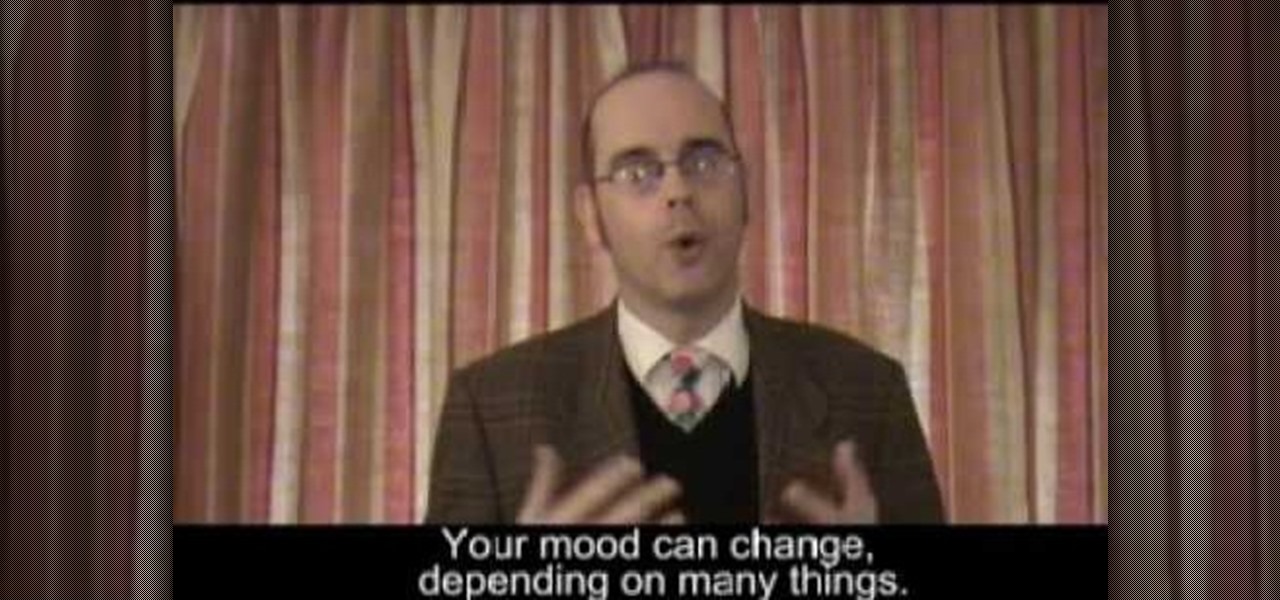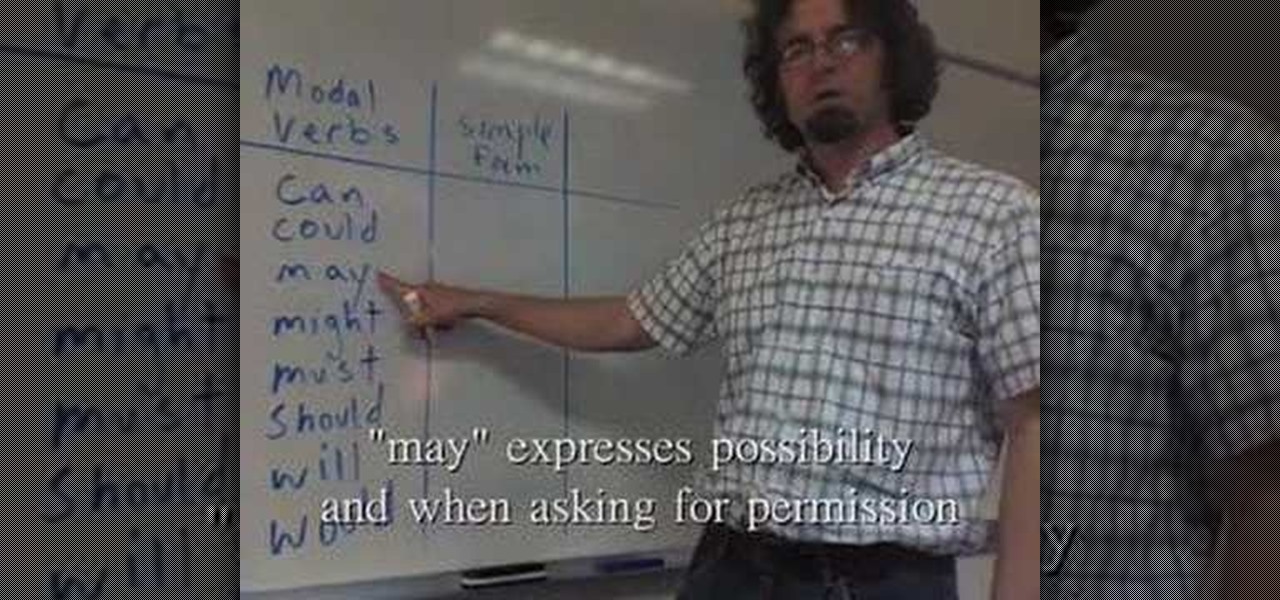Hot English Language & Culture Posts


How To: Use modal verbs in the passive voice in English
Modal verbs in the passive voice follow this pattern: Modal + be + past participle. There are many possibilities with modal verbs. This ESL tutorial gives a basic description of how to use modal verbs in the passive voice. Watch this how to video and you will be speaking English properly in no time.

How To: Use the passive voice in the future tense in English
Learn how you can use the passive voice in the future tense in this ESL tutorial. To make the future tense passive in English, use "will be" and then the past participle. "Will" is a modal verb, so this formula applies to other modals such as can, may, must, might, etc. Watch this how to video and you will be speaking English in no time.

How To: Use the passive voice in past continuous in English
In this ESL tutorial you will learn how to use the passive voice in the past continuous tense in Englishi. The passive voice is the form of a transitive verb, that requires both a subject and one or more objects. To put the past continuous tense into the passive voice, use "was" or "were" depending on the subject, then "being" and then the past participle. Watch this grammar how to video and you will be speaking English in no time.

How To: Use the past tense passive voice in English
Learn how to use the English past tense passive voice in this how to video. The passive voice is the form of a transitive verb, that requires both a subject and one or more objects. To make the past tense passive, use "was" or "were," depending on the subject, and then add the past participle.

How To: Use the passive voice in present continuous in English
Learn how to use the English passive voice in the continuous tense in this tutorial. When the present continuous tense is in the passive voice it looks like this:

How To: Use the passive voice in the present tense in English
This ESL how to video teaches you the use of the passive voice in the passive tense in English. The passive voice is the form of a transitive verb, that requires both a subject and one or more objects. In the present tense, the subject changes the verb "be" and then you use the past participle of the main verb. Watch this tutorial and you will be speaking English in no time.

How To: Use the phrase "would rather" in English
"Would rather" is used to show a preference for one thing over another. What do you want to do today, go to the beach or go to work? I would rather go to the beach. Or, I'd rather go to the beach. In this ESL how to video you will learn the use of the phrase "would rather" in English. You will also learn how to construct the contraction of "would rather." Watch this how to video and you will be speaking English in no time.

How To: Choose an accent when speaking English
Which is the best way to speak? American English or British English? The truth is that you do not have to sound like anyone! You create your own individual sound. As long as people can understand you, then that is all that matters.

How To: Thank someone in English
This ESL lesson goes over saying "thank you" in English. There are many words and phrases to thank someone in English. This language tutorial teaches you numerous ways for you to express gratitude in English.

How To: Talk about friendship in English
This ESL lesson talks about friends and friendship. Friendship is very important to being a happy and fulfilled person. This language tutorial teaches you how to describe your friends in English. Learn American and British words and phrases to describe your best companions with this how to video.

How To: Abbreviate words in English
In this how to video we look at abbreviation in English. Abbreviations make longer words faster to type and easier to say. This ESL lesson teaches you some common British abbreviations and how to use them. Abbreviations are constantly being invented. Try to make up your own!

How To: Differentiate between irony and coincidence in English
In this English language lesson we look at irony and ironic situations versus coincidence and coincidental situations. In English, irony and coincidence are often confused. This ESL tutorial teaches you how to correctly identify the difference between these two concepts.

How To: Describe the feeling of fear in English
In this English language tutorial we look at fear and being afraid. There are many words to convey the emotion of fear and anxiety. This ESL lesson teaches you how to talk about your fear and the names of some common phobias.

How To: Describe a famous person in English
In this English tutorial we look at fame and words connected with it. There are many words to describe a person who is famous or a "star." This ESL video lesson teaches you how to talk about well known people in the English language.

How To: Use English slang
In this ESL language tutorial we look at English slang. Slang is when you replace a common word or sentence with a totally new one. English slang often depends on the country and then region of the country you are in. This how to video teaches you some widely used slang words and phrases that you can say in English. Try out the words in this lesson and you will be "shooting the breeze" in English in no time.

How To: Use English words to describe your personality
In this ESL how to video we look at your character and the English words that describe it. The way you act or the way you behave among other people is very important... at least it is to you! Learn how you can use positive and negative descriptive words to talk about yourself with this English tutorial.

How To: Read British or American body language
In this English video lesson, we look at body language and facial expressions. Learn how to recognize certain signs and messages that are conveyed through body language with this ESL video. The hidden signals in this video are common to Britain and the USA.

How To: Master English grammar
In this ESL language tutorial, we look at the hardest part of learning English, grammar. English grammar is quite inconsistent, but with this how to video you will be able to start learning English with ease.

How To: Speak English with proper intonation
Learn how to speak English with falling and rising intonation or cadence. This is a lesson in four parts.

How To: Lesson 6a -- Prepositions -- Common Mistakes in Englis
Learn how to use English prepositions in the context of meals. This is a lesson in two parts. Highlighted prepositions: AT, BEFORE, AFTER, WITH, and FOR. Level: Intermediate.

How To: Know what words to stress when speaking English
Learn what English words to emphasize in phrases and sentences. Develop your awareness of rhythm in English speech. Learn to stress words correctly and naturally.

How To: Pronounce similar vowel sounds in English
Watch to learn how to pronounce some English words that have similar vowel sounds but different meanings like stuff - staff, hair - her, cut - caught.

How To: Write an argument essay outline
Here is a brief outline of how to organize an effective argument essay. This structure can be adapted to your needs and follows IELTS essay writing guidelines.

How To: Link an essay's paragraphs together
This brief video outlines how to keep the paragraphs of your IELTS argument essay linked.

How To: Write a discussion essay outline
This two part video is a short lesson outlining the basics of writing a discussion essay. It is about 13 minutes long in total.

How To: Write a discussion essay
In this video lesson, we write a discussion essay together following IELTS essay writing guidelines. The final essay is roughly 280 words in length.

How To: Use the phrase "had better" in English
An English teacher explains how to use "had better." This is an idiomatic modal which closely resembles "should," but it's a little stronger than "should."

How To: Use the past perfect tense in English
An English teacher shows how to make the past perfect tense: had + past participle. The past perfect shows that something happened before another past event.

How To: Use the phrase "get used to" in English
Learn how to use the phrase "get used to" in English. "Get used to" expresses that you have adapted or become accustomed to something you may or may not like. At first you don't like something, then you "get used to it."

How To: Ask questions in the present perfect tense in English
An English teacher shows how to make the present perfect tense in the form of a question.

How To: Use the present perfect tense
In this video an English teacher explains how to make the present perfect tense.

How To: Use the modal verb and continuous form in English
Some modal verbs can be put in front of the continuous form to express some present action that is or isn't happening. To make the past tense for each, use "have been" instead of "be."

How To: Use "must" in English
Learn how to use the modal verb "must" in English. The modal verb "must" is almost the same as using "have to," but often "have to" sounds better in spoken English.

How To: Use "(be) able to + main verb" in English
An English teacher shows how to use "be" able to" with modal verbs. Remember that "(be) able to" is almost the same as the modal verb "can."

How To: Use modal verbs in English
An American English teacher lists modal verbs and briefly explains their use.

How To: Use gerunds in English
A teacher explains what gerunds look like and how they might be used in English.

How To: Use infinitives in English
An American English teacher explains how infinitives are used.

How To: Use "either" and "neither" in English
An English teacher shows how to use "either" and "neither" to make negative statements. These words are the opposite of "so" and "too."

How To: Use helping verbs and main verbs in English
This short video shows how helping verbs are used with main verbs in English.

How To: Pronounce regular verbs in the past tense in English
This video shows to pronounce regular verbs in the past tense in English.






